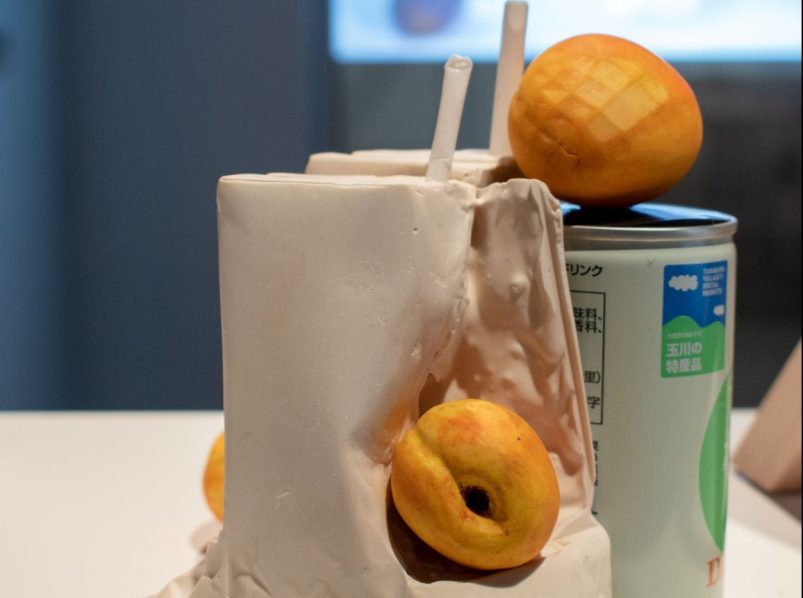There’s life in everything
Previously named Mois de la Photo, the Momenta Biennale is an extensive series of themed exhibitions in galleries all over Montreal occurring every other year at the same time as the World Press Photo exhibition. This is done intentionally, to emphasize the power of different images. The theme of this year’s biennale, titled The Life of Things, is materiality, material culture, consumerism, and environmentalism. The theme is interpreted differently by 39 local and international artists, with some focusing on living things, others on objects, oral histories, and movement.
The exhibition at Galerie de l’UQAM, where their biennale launched, is divided into two segments, “Cultural Objects and Material Culture” and “Thingified Beings or Humanized objects.” International artists explore identity and the body, and the legacy left behind by objects in various light-based and time-based mediums. Kader Attia, an artist based in Algeria and France, put forward a striking silent projection that explores the “restoration” of people (specifically severely wounded World War I soldiers) and mended artifacts from museum archives. The restoration methods between two very different subjects are surprisingly similar, sharing basic cross stitch methods, and once healed, leave noticeable patterns in the visible scar tissue. Across the gallery, Victoria Sin (Toronto/London) showcases a four-part series exploring the art of drag and its role in defining “femme” culture.
Stepping off from “Cultural Objects and Material Culture” and “Thingified Beings or Humanized objects,” the exhibition at VOX, centre de l’image contemporaine presents “The Absurd as Counter-Narrative of the Object” and “Still Life in an Age of Environmental Crisis.” Among the nine artists at VOX are Concordia alumni Juan Oritz-Apuy, Bridget Moser, and Elisabeth Belliveau.
Centred around the idea of the still life, Belliveau’s work addresses consumer society, inviting us to look closely at things and choices. Belliveau Works with installation, found objects (both authentic and replicated), video, and stop motion animation, to depict a feminist means of art making.
By analyzing still lives created by women in the 16th century, this painterly subject, separate from that of the body, invited these women to focus on something domestic and hide their own self-portraits in reflections of the objects on the table. Belliveau, drawing from this, is interested in how things came to the table, making connections to the aestheticization of food in the digital world with the rise of “foodie” accounts on Instagram.
Her work at Vox, Still life with Fallen Fruit depicts objects collected upon months spent in Japan. Parallel to traditional bronze casting, Belliveau chose to scan fruit, namely apricots and figs, which had fallen from trees in the Japanese countryside, and 3D print them, thus navigating the ultimate decay of her subject. The other objects in her installation are rich with personal memories, and while they may be mundane, she wishes to emphasize the symbolic meaning behind the objects and not their material value.
Her work permits viewers to slow down, analyzing the material hierarchy of things, questioning economical consequences and validating the breath of life that animates objects in question, real or replicated.
Working in tandem, Oritz-Apuy’s installation poses a striking take on ideas previously set by Belliveau, contextualized by the absurd and the still life in the Anthropocene. His video collage presents select, existing Youtube unboxing videos, overlapping the language and care used to unwrap various products from their packaging. Oritz-Apuy is fascinated by relationships with commodities and the way in which they may replace relationships with people. His work is self-conscious, critically analyzing the absurdity of this unboxing phenomenon and nonetheless, being completely taken by the beauty of objects. Oritz-Apuy’s installation practice is characterized by a bold, intentional use of colour, painted in stripes on the walls, transforming the initial white cube setting. On a wall opposite of the video collage rest his fetishized objects; monuments stripped from their packaging labels to highlight their form, colour, and contour.
This year’s Momenta Biennale continues to toy with these ideas of things, stuff and what they reveal about our society and consumer culture. MAKING A RELIGION OUT OF ONE’S LONELINESS, by Canada’s Hannah Doerksen at Centre CLARK continues to use objects, this time embedded with the artist’s personal encounters, are used to create a space of “mystical contemplation.” The idea of the altar, a recurring theme within the Biennale, returns in another form with Celia Perrin Sidarous’s work at the McCord Museum titled The Archivist, which traces museological practices tied to archiving images and objects, resulting in inkjet print montages, a different kind of narrative-embedded still life.
For more information regarding Momenta’s many incredible exhibitions, workshops, talks and other activities read more here. Entrance to these various venues is free until mid-October, and there will be a french guided tour of the Biennale’s exhibitions at the Galeries de Gaspe on Sept. 14 from 3:30 p.m. to 5 p.m.
Photos by Cecilia Piga.
